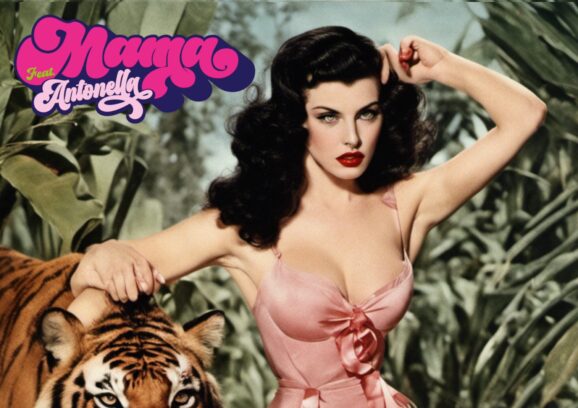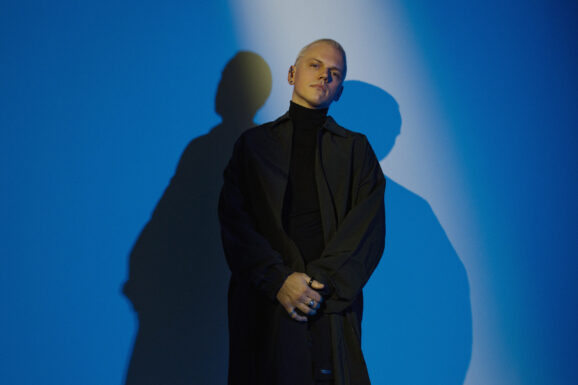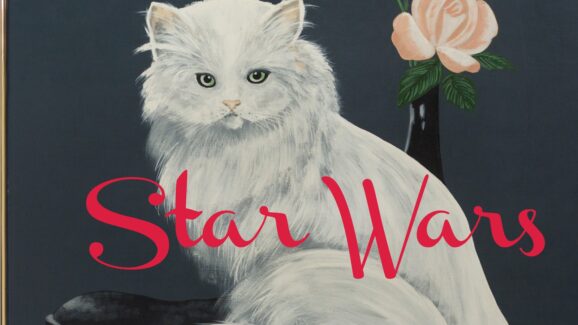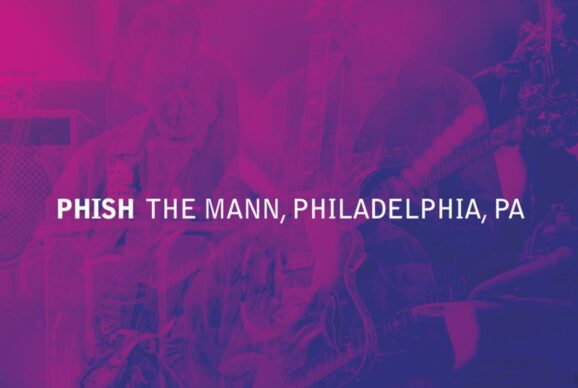Knox Chandler is known as an instrumentalist, and as a Producer, and arranger. With his new solo release, titled, The Sound, he also brings in his painting and writing to create a multi-media project that takes the form of a book with an accompanying musical download. Memoir-like, The Sound documents Chandler’s encounter with the Connecticut shoreline and countryside after moving from his expatriate home of Berlin to his mother’s farmhouse to be a caregiver. It marked a very sharp contrast between the urban and the rural for Chandler, who had also been part of an artistic community in New York City in the 1980s.
Somewhat unplanned, the project began to take shape around Chandler’s exploration of visual art elements and his “Soundribbon” style of live instrumental recording based around the guitar, and accompanied by upright bass and percussion. Now complete, the project arrives on Knox’s new label, Blue Elastic, on May 30th, 2025, and will be available either as a digital download or streaming musical collection, or as the hardcopy book with download code. Today, Glide is excited to offer an exclusive premiere of the album in full.
While Knox is known for his career as a member of The Psychedelic Furs, Siouxsie and the Banshees and the Cyndi Lauper band, and working with acts such as REM, Depeche Mode, Grace Jones, Marianne Faithful, Natalie Merchant, and more, this marks his most personal project to date. I spoke with him about artistic communities, working in isolation, and the development of The Sound.
I know that you previously lived in Berlin. I feel like that time in your life started you on the path of becoming more experimental, or at least started you on the path that you’re on now.
It started me on the path that I’m on now, yes, certainly. A bandmate, Bucky, from Siouxsie and the Banshees, had moved there, and suggested that I make a move to Berlin. I was pretty much done with New York at the time, so I went and lived with them for a couple months, and then got my own place. By that time, I knew I was going to stay in Berlin. I started to get deep into the processing techniques that I use today, and it pretty much changed my tools, but I kept the aesthetic.
As technology has been progressing since then, there have also been more possibilities, too, or do you try to stick with older methods?
I’ve always tried new stuff out. I’ve been that way for decades. What I did when I moved to Berlin is that I tried a lot of different things, and a lot of things didn’t work. It took me a while to find my voice in this new stage of processing guitar. I have a fellowship of friends who dabble in iPad apps and pedals, and we try things out. I’m always finding something that speaks to me, that’s new, and I try to utilize it in my work. I find that if I stick too much to what I’ve been trying all along, it gets pretty sterile for me.
I tend to associate Germany with being a safe haven for experimental music. Did you find that to be true?
Yes, absolutely. When I got there, it was fantastic. There were lots of places to play. Even performance art was such that I hadn’t experienced it in decades, but when I got to Berlin, there was tons of performance art going on. It was like it had been back in New York when I first moved there in the 80s. That was very exciting, that there was art, dance, and different musical genres. It felt like a melting pot.
It was like my experience of New York City in the early 80s, where rents were real cheap. People could do a day job for a couple of days to save enough money to do their art for the rest of the time. I saw a lot of that in Berlin, and then covid hit. I was just there in February doing some shows, and I was really surprised by how much the city had changed. It had gotten a lot more expensive, and there were more start-up companies. Even though there were places to play, it felt like a different vibe than 13 years prior.
That reminds me of the changes I can see in New York now. These places that used to be very human now feel impersonal, lots of banks and empty real estate.
Very much so. That’s true in New York City. I still have a place with my ex-wife in the East Village, and I was just there, and don’t recognize it. I don’t recognize the people. It’s very white and very rich. It used to be a real melting pot of everyone and everything, though it was dangerous, too. They started clamping down on crime, kicking out the homeless and squatters, and developing it, and it hasn’t been the same since.
It seems kind of irreplaceable to have a geography where art is happening. I won’t say it doesn’t still exist, because two places I’m familiar with, Asheville, North Carolina, and Portland, Oregon, are both very creative. But do you think people are now going to be missing out on the kind of experiences you had with creative communities in New York and Berlin with the way we’re living now?
Yes, there’s becoming less of a community. That’s my observation. You find these places that are kind of run down, and crime is kind of high, then creative people come in. Then they get older and start having children, and getting involved with the school systems, which start improving. Then you see more and more people flocking into those areas as a safe place to live. Then prices and real estate starts to go up. Before you know it, you’ve priced out a lot of interesting people. I’ve seen that in New York and Berlin.
There is another way to make art, of course, which is a very hermit-like existence, where you focus on what it is that you, as an artist, want to do and say. I feel like The Sound is that kind of project for you. You were very focused and internalized, though you were using your surroundings, too.
That’s exactly what the project is. I came back here after covid let up, where I could come back to the States and visit my mom and my son. My mom lives in this old farmhouse, and it’s beautiful, with barns, fields, and ponds. I realized that she could not take care of herself in this house. I made the decision to move back here and take care of her. So I was her main caregiver for two years, until she moved into an assisted living place. My intentions weren’t to come here and make art, my intentions were to take care of my mom.
But I go to bed, and then I wake up, thinking about music. So I set my studio up in the house, and I forced myself, with the hour I got here or there, late at night, to try to create some new stuff. I felt totally uninspired. After living in major cities for over 40 years, I was missing the street, the smells, the sounds, the posters, everything. I was also missing the connection to like-minded people, venues, and museums. It can be awfully beige here, but very pretty. I was looking out the window, and thinking, “It’s very beautiful, but I don’t feel anything.”
I started forcing myself to go out and take walks. I moved in the winter, and by the time spring came, I got into fly fishing, since I’d always wanted to take up fly fishing. There are beautiful rivers in Connecticut, and I’d go stand in the river for hours, and taking these hikes. I’m right on the coast of Long Island Sound, so I’d go down there, and we call it “the Sound”, actually.
I started getting a lot of inspiration from nature, and it happened very fast. At the same time, I was doing a lot of journalling, painting, and photographs. So this all came about naturally. Once my mother moved out, I realized, “I just have to put this all together.” Instead of making a vinyl or CD, I thought, “I’ll just make a book out of this.” It pretty much documents this period, over the past few years, of this transformation from urban to rural inspiration. I put it in a book rather than just having an album cover, and put the download code inside the book.
I’ve come across a couple of musicians who have been doing that in recent years, because they have photography or art backgrounds, and have brought the two fields together. I’ve also heard of people creating art products, like tarot card decks, or other collectible art items, and combining them with digital downloads.
I have a friend in Berlin, King Khan, and he would do the tarot cards. Then, another friend I worked with in the 90s, Darden Smith, put out a book. We were talking, and I said, “I have all this artwork, and all this writing, and I want to do something different than vinyl.” He sent me his book, and his record, and I couldn’t see myself doing a book like he’d done, but maybe an art book. He said, “You’ve got to do it!” He was a motivator, as well as a couple other friends.
That’s wonderful, when you’re doing something totally new, to have some lights to follow. When did you start creating the music? Was it after the visual aspect or at the same time?
Some of it was before, and some of it was after, and some was at the same time. I had two records that I’d finished mixing and got them mastered here. I thought I was going to put those out, and a friend suggested that I start doing artwork for those records, but I just couldn’t connect. Trying to do that, I instead went down this whole other road of visual stuff, with artwork, and photographs. Then, I was also recording what I call “Soundribbons.” They are these instrumental soundscapes. Part of my liminal space is that I don’t use any pre-existing audio. It’s all processing whatever instrument I have plugged into the system. And it’s all in real-time.
So, there are no samples, just what you’re creating, and it’s captured in real-time?
Yes, it’s captured in real-time. I recorded these, and when I started getting more into doing the hikes, and being around the water, especially, I started feeling the rhythm of this area. The rhythm of the water, and the rhythm of the trails that I was hiking. Then I started doing these Soundribbons to my liking. Before I was just tossing them aside and thinking I would go back to them later. At the time, I was also in touch with my friend Bobby Prevert, a percussionist who I had worked with before I went to Berlin, and we decided to do a record together. So I started making pieces out of these Soundribbons. That record came out a couple of months ago.
But at the same time I was doing that, I was still experimenting with this other stuff that was very much connected to the writing I was doing, and the paintings, and the sketches. They were going in a similar but different direction. I just kept doing all these things at the same time, and was realizing that it was all very much connected. I had stumbled upon this thing that I had never really experienced before, because I had never delved deep into trying to do a project like this. I didn’t necessarily know that it was going to be the book at the time, but I was just very inspired, both artistically, and musically.









